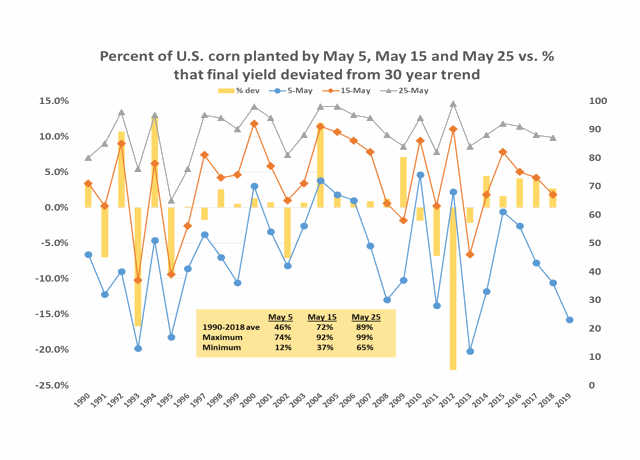Fundamentally Speaking
Corn Planting Trends
The USDA this week reported that as of May 5th only 23% of the nation's corn crop was in the ground, up a mere 8% from the prior week and the fourth slowest pace as of that date since 1990. This planted percent trails the 13% reported in 1993, 17% in 1995 and 12% in 2013.
This chart looks at the percent of U.S. corn planted by May 5, May 15 and May 25 on the right-hand axis vs. the percent final yields deviate from 30-year trend on the left-hand axis.
P[L1] D[0x0] M[300x250] OOP[F] ADUNIT[] T[]
In addition to concerns that late corn plantings could result in some intended acreage not getting seeded to that crop, tardy seedings often lead to below trend yields. Below trend yields may also be linked to less input application, more of the crop subjected to late July (hotter) as opposed to early July temperatures during the critical pollination phase and a later maturing crop that more easily could be nipped by fall freezes.
That final yields in those three other years noted came in respectively 16.7%, 9.1% and 2.2% below trend. However, note that 1993 was considered the great "flood' year, 1995 saw very hot summer temperatures and 2013 followed up on the big drought year of 2012, so subsoil moisture conditions were far below those prevailing this season.
The average planting pace as of May 5 is 46% with the average ten days later at 72%, a gain of 26% and then days after that on May 25 it is 89% and advance of 17%. At the average, this would imply that the 2019 crop would be 49% planted by May 15, again above the three mentioned years with just 37% planted in 1993 as of that date and a 17% after that would have the 2019 crop 66% planted by May 25 with only 1995 slower as of that date at 65% planted.
The box within the graph details the fastest ten-day planted pace between May 5 and May 15 was a gain of 45% in 1992. The slowest pace was a mere 12% in 2010, although that still resulted in 86% of the crop planted by 5/15/2010. The biggest jump between May 15 and May 25 was seen in 1993 of 39% with the most sluggish jump seen in 2000 of 6% but the crop was essentially all planted by 5/25/2000.
Given a wet forecast this week it seems likely that we will be looking at delays on par with 1993 and 1995. So far this has had limited impact on futures which are also looking at the ongoing trade wars and what appears to be a lackluster demand outlook.
(KLM)
© Copyright 2019 DTN/The Progressive Farmer. All rights reserved.





Comments
To comment, please Log In or Join our Community .